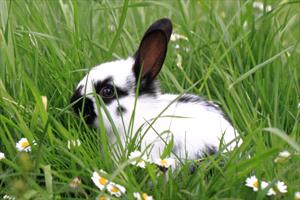Rabbit in Grass

Image Courtesy Deposit Photos
Many rabbit owners are familiar with gastrointestinal (GI) stasis and its common causes. Stasis is a stoppage or slowing of blood, body fluids, or intestinal contents, and in the case of rabbit GI stasis it refers to ingesta in the bowel. Rabbit owners are aware that GI stasis is not a disease per se, but rather it is a common symptom of many rabbit diseases.
Dental Disease
Perhaps one of the most common causes of stasis is dental disease. For this reason it is critical that you allow your veterinarian to perform a thorough physical examination, including a detailed dental exam, on your rabbit at least once a year. As your rabbit ages or if he has had dental disease in the past it is possible that your vet will advise that your rabbit's teeth be examined more frequently. Additionally, any rabbit experiencing GI stasis should have a dental exam as part of the work up. There are many different types of dental disease, from the growth of relatively minor molar points (or spurs), through severe dental abscesses and potentially compromised jaw bones. It is important to note that certain types of dental disease can only be detected with radiographs (X-rays) and/or a sedated oral examination.
Gastrointestinal Disease
Many types of gastrointestinal disease can contribute to anorexia and stasis in rabbits. When this occurs the stasis is known as primary GI stasis. One of the most common causes of primary GI stasis is a poor quality diet. Rabbits have a large fiber requirement, and the bulk of their diet should consist of high quality grass hay. In younger, and in some geriatric rabbits, alfalfa hay is recommended as it is higher in protein and calories as well as calcium. GI stasis is likely to occur in rabbits fed only pellets, or worse yet those fed diets high in sugar and starch, as occurs with rabbits fed oats and/or cereal. Other types of GI disease can cause stasis and these diseases will likely require blood tests, radiographs and various fecal tests to accurately diagnose.
Kidney and Bladder Disease
Kidney and/or bladder disease are perhaps the third most common cause of GI stasis in rabbits. It is believed that the pain and possible toxin buildup in the case of kidney disease lead to anorexia and secondary stasis. Diagnosis may be straightforward in the case of bladder stones, which can be readily palpated at times. However, generally speaking a diagnosis of stasis secondary to kidney or bladder disease will require a detailed physical exam, complete blood work, radiographs and a urinalysis. Depending on the underlying case many of these rabbits will recover their appetite and have resolution of their urinary system disease with appropriate veterinary care.
Reproductive Disease
The vast majority of rabbit owners know the importance of having female rabbits spayed. It has been reported that up to 80% of unspayed female rabbits will develop uterine disease in their lifetime. Sadly, most of these cases will involve the development of potentially fatal uterine cancer or aneurysms. Usually the first symptom noticed by owners is seeing blood in the urine or on the rabbit's back end. However, an equally common initial symptom is GI stasis secondary to the uterine pathology. A tentative diagnosis may be achieved based on the pet's history and symptoms; however a detailed physical exam, radiographs and potentially exploratory surgery (which may be curative if the rabbit is spayed) may be required.
Toxicoses and Lead Paint
It is uncommon for well-cared for rabbits to gain access to toxins. However, after practicing in New York City for several years I have seen many cases of GI stasis secondary to low-grade, chronic lead intoxication. These pets invariably live, or have lived, in buildings built before 1978. That was the year in which the sale of lead paint was banned in the United States. Many rabbits with lead poisoning are "free-range" rabbits. They spend their day out of an enclosure and have the run of the house. Owners may or may not be aware of their rabbits chewing at baseboards, door frames or walls. When lead poisoning is suspected, many owners will state that their home is lead free, even if it was built before 1978. These owners often erroneously believe that renovations and fresh paint means that the lead-based paint has all been removed. This is almost never the case; more often than not the renovations simply cover deeper layers of lead-based paint.
Lead toxicosis appears differently in rabbits than in cats and dogs, and it is unlikely that a non-rabbit savvy vet will suspect this condition. In dogs and cats symptoms are often pronounced, and many times include overt neurological disease. It appears that rabbits are more sensitive to low levels of lead in the blood, perhaps because of their complicated gastrointestinal system. In my experience, lead-poisoned rabbits often demonstrate GI stasis, weight loss and anorexia of several days to weeks' duration. The symptoms may wax and wane, but no other cause of GI stasis can be found. Lead levels are often in the high normal to low toxic range for dogs. With appropriate treatment the vast majority of these patients make a full recovery.
Conclusion
GI stasis can vary from relatively simple condition for your rabbit vet to diagnose and treat, through one of any number of more complicated and serious medical conditions. You should always seek help from an experienced rabbit vet as soon as your rabbit has showed decreased appetite, or anorexia of 12-hours or more. Owners may not always notice their rabbit's appetite, and as such decreased fecal production may be the first clue to GI stasis. Once this is noticed a veterinarian should be contacted immediately.